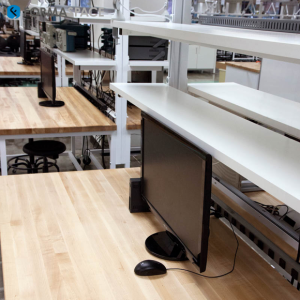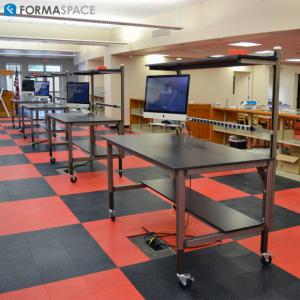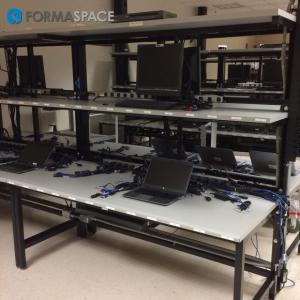There’s a Right Way to Leverage the Newest IT Infrastructure for K-12 Education
The IT requirements for K-12 institutions are expected to grow faster. Learn how to build a state-of-the-art IT infrastructure for K-12 education.
AUSTIN, TX, USA, October 28, 2019 /EINPresswire.com/ -- Why are IT systems for K-12 education so complicated?Even the most modest-sized K-12 school districts face complex IT requirements that rival those of many large commercial businesses. How can K-12 education navigate the ever-changing IT infrastructure landscape and come out on top? We take a look.
A generation or two ago, the IT requirements for K-12 Education systems mostly revolved around managing employee HR benefits and payrolls, facilities maintenance and capital improvement budgets, library and textbook inventories, athletics programs, bus transportation, as well as student health and attendance records, test results and grades.
It was a much simpler time.
But the same switch to project-based learning that turned classroom facility design on its head has caused the IT requirements for K-12 education to grow exponentially as well.
Within a few years, K-12 IT teams have found themselves facing service challenges that rivaled, or even exceeded, those of similarly sized private commercial businesses.
The IT requirements for K-12 institutions are expected to grow even faster, thanks to a range of developments, including:
•Deployment of Virtual and Augmented Reality (VR/AR) education systems that use advanced hardware and video simulations, such a Google Expeditions.
•Groupware apps, such as Top Hat, that allows instructors to create, share, and deploy sophisticated training materials with built-in assessment tests.
•AI-based tools that perform formative and summative student evaluations and provide just-in-time recommendations/changes to computer-based training systems for each individual student.
•Widespread adoptions of voice-activated automation systems, which are just starting to ripple through existing computer solutions (think Alexa, Siri, Google Translate, etc.).
•Enhanced security monitoring systems designed to prevent active shooters from gaining access, as well as assist first responders in the event of emergencies.
The world of IT is full of jargon. Use this Quick Reference Guide to dispel the mystery behind some of the newest IT terms being thrown about.
Formaspace builds heavy-duty industrial workbenches for the new makerspace at Brophy Prep School. Built-in casters allow the furniture to move easily and upper storage provides a convenient way to help maintain order.
As Murphy’s Law says, anything that can go wrong will go wrong. It’s just a matter of time.
Unfortunately for K-12 IT Administrators, the consequences of unexpected IT downtime can be a very public and humbling experience.
Not only do you have the traditional stakeholders, such a school administration staff and teachers (even the district supervisors, if things go especially awry), you also have all the students — and their parents — to answer to if access to services they’ve come to expect is suddenly unavailable.
In fact, the bottom line is it doesn’t matter if your ISP has a network outage cutting you off from the internet, if the power grid goes out in a lightning strike and the emergency backup generator doesn’t work, the roof or a pipe leaks and fries the power supply on the server rack, the landscape maintenance team drags a backhoe over your fiber connections buried underground, or the A/C system in your Data Center fails, causing all the plastic connectors to melt — the result is the same: hundreds if not thousands of users who complain they can’t do anything.
In plain English: downtime is a disaster in the making.
And the consequences of a down system day might make for a comparatively good experience compared to some of the unattractive alternatives, such as lost or compromised data due to hardware failures or virus infections (or worse, active data breaches by hackers), accidental exposure of private information, and so on.
What can K-12 IT administrators do to simplify their lives and make their data centers more resilient?
Many of today’s systems architects are questioning whether the Three Tier Systems Architecture traditionally used in data centers still is up to the task.
There’s nothing fundamentally wrong with the idea of separating the network topology into three buckets, e.g. data computing, data storage, and data networking. The problem comes with scaling up to handle ever-increasing requirements from the users.
All those new on-demand educational software systems (see outlined above) translate into the need to provision, operate, and maintain an ever greater number of servers, SAN storage systems, and data network gear to handle it all.
Yet many school systems are burdened with “data center” setups that are, shall we say, highly improvised — reports of K-12 IT systems housed in unused storage closets, or even converted restrooms, are not unheard of. The operational shortcomings stemming from these kinds of “unplanned” infrastructure setups are only made worse by the need to cram more gear into these improvised “data center” spaces to keep up with growing IT demands.
Formaspace’s experience building tech lab equipment includes working directly with computer manufacturers. This rack system for prototype server testing features electric hydraulic height adjustability and built-in ESD protection.
1. Cloud-Based Virtual Data Centers
Fortunately, there are new technology infrastructure alternatives available to K-12 educational institutions.
The first option is to outsource your infrastructure and let it live on the Cloud, using an Infrastructure as a Service (IaaS) provider.
The advantage of this approach is that the major public Cloud providers (including market leaders Amazon, Google, Rackspace, and others) make it very easy to “spin up” a new virtual server on demand. You no longer have to provision, maintain, or upgrade Data Center servers or storage, and many plans allow you to pay on a usage basis (a.k.a. Power by the Hour).
The disadvantage of this approach is that it doesn’t entirely eliminate the need for an onsite IT tech lab, even if it’s just for development, testing, and deployment of cloud-based apps.
But not every application is suitable for deployment on the cloud, for several reasons. Yours might be tied to a legacy system that would be expensive and time-consuming to replace with an online system if an equivalent one is even available. Control over data is also a critical consideration: many school district administrators are uncomfortable with the idea of having data being exposed to the wider internet, much less being hosted offsite by a third-party Cloud Computing provider.*
*The emerging market for Cloud Access Security Brokers (CASBs) is intended to make the connection to and from Cloud services more secure, but it adds another level of complexity.
Finally, many of the newest applications used in education are not only big bandwidth hogs (such as video streaming services, games, and voice-activated apps), they also require low latency (e.g. instant response) — which does not play to the strengths of Cloud computing architecture.*
*In response, Cloud service providers have begun touting Hybrid Clouds or so-called Edge Computing architectures, which bring servers closer to the user to reduce latency times. (In other words, what is old is new again!)
Verdict: Cloud Computing can be the right solution for specific use cases, such as creating on-demand development environments, or for on-demand storage and application deployments where data privacy concerns and latency issues are not critical.
2. Enhanced On-Site Virtual Server Data Centers: HCI (Hyper-Converged Infrastructure)
Not so long ago, Data Center network topologies were easy to understand. Under the Three Tier Systems Model, you had your server, your storage system (typically a SAN), and your networking gear.
As we alluded to earlier, scaling up used to mean buying more of each, which took up more physical space, required more cabling, more air-conditioning, and most of all, more patience.
The first breakthrough came in server design. Borrowing an old concept from mainframe computing, server manufacturers implemented the Hypervisor concept (also known as a Virtual Machine) on PC-based servers. This approach allows a single computer server on a rack (often referred to as a ‘blade’) to emulate the operation of more than one “virtual” servers — on that one single machine.
Let’s say you run a total of 5 virtual servers on one physical server, which is a conservative number. That saves the cost of procuring and operating 4 additional physical servers, which is a massive saving.
Now let’s go one step further. What if you could emulate the storage systems and data networking gear as well?
Read more ... https://formaspace.com/articles/education/new-it-infrastructure-for-k12/?utm_source=einpresswire&utm_medium=content&utm_campaign=article-102319
Mehmet Atesoglu
Formaspace
+5122792792
email us here
Legal Disclaimer:
EIN Presswire provides this news content "as is" without warranty of any kind. We do not accept any responsibility or liability for the accuracy, content, images, videos, licenses, completeness, legality, or reliability of the information contained in this article. If you have any complaints or copyright issues related to this article, kindly contact the author above.





